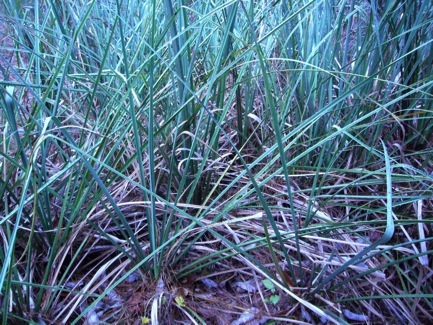Cladium jamaicense: Water finder
In Wekiva Springs state park in Florida there is a high and dry stretch of scrub pine and palmetto bushes, and oddly, a bunch of water-loving sawgrass. The area is dotted with little and gigantic springs and the sawgrass pictured left, in that dry environment, is the only indication of the spring underneath. Normally it is found in standing water.
Sawgrass gets a lot of bad press. Even though it covers most of the Everglades and its relatives can be found in most of North America except the northern plains, few have anything good to say about it. Apparently even most animals avoid it. But, It is edible. However, I didn’t say it was easy to get at.
Sawgrass is correctly and incorrectly named. First it is not a grass but a sedge. Sedges have edges, grass have stems. But the saw part is right. In fact, in Haiti it is call the “razor herb.”
The sedge is armed with very fine saw teeth and will cut you quite easily (though a useable blade in nature if you need one.) The heart of leaves at the bottom are edible. They taste similar to heart of palm but not as sweet. Some say the young shoots are edible but I don’t see how. Elsewhere in the world some sawgrasses have edible roots. Sawgrass roots are too tough.
Its botanical name is Cladium jamaicense (KLA-dee-um ja-may-KEN-see.) Cladium is from the Greek word kladion, or branchlett, referring to the flower spike. It was named by botanist Patrick Browne in 1766. The other native species are C. mariscoides (latin: mar-is-COY-dees Greek mar-is-KEE- deez) and C. californicum (ka-li-FOR-ni-cum.) Edibility unknown to me. A species in the old world is Cladium mariscus (mar-RISK-us.)
Oddly enough, the top of sawgrass often has little worms in it that are excellent bait for fresh water fish.
Green Deane’s “Itemized” Plant Profile
IDENTIFICATION: A tall, coarse,perennial to nine feet, usually three; leaves long and thin, flat V-shaped blades with sharp teeth on the edges and underside mid-vein. Flowers rusty brown spikes up to 3 feet long above the leaves. Leaves tend to cut one way, when pulling away from the plant.
TIME OF YEAR: Grows year round in Florida, summer and fall elsewhere.
ENVIRONMENT: Edges of wetlands or freshwater lakes. Grow in a scrub area usually means a spring nearby.
METHOD OF PREPARATION: Inner bottom white core of stalk, raw or cooked. WARNING: It cuts flesh very easily.



I have not seen any sawgrass around here but I think we might have a close cousin. Torpedo grass and it is all over the place. A shorter version but cuts just the same. I don’t think there is enough of the bottom of the leaves to eat.
Hey Green Dean,
Its Willy form Florida Earthskills.
Are the sawgrass seeds edible? There seems to be quite a lot of them tight now.
By the way the 2014 dates for FL Earthsills are Feb. 6-9th. Hopefully you can make it! We’ll be in touch about it.
Thanks!
Willy
The seeds are usually used to treat high blood pressure, so while they may be edible I think the cautious answer would be no.
I wonder if torpedo grass roots are edible?
Root are not mentioned but there are some reports the seeds are edible. It is not native to North America.
Sawgrass is an invasive all over the California coast. I recently pulled some sawgrass and realized the inner stalks pulled out just like certain types of grasses. The inner stalks were soft and tender and I took a bite. The taste was mild and even slightly sweet and it was quite edible. I may have gotten lucky and pulled it at the exact right time of maturation, but it was good food.